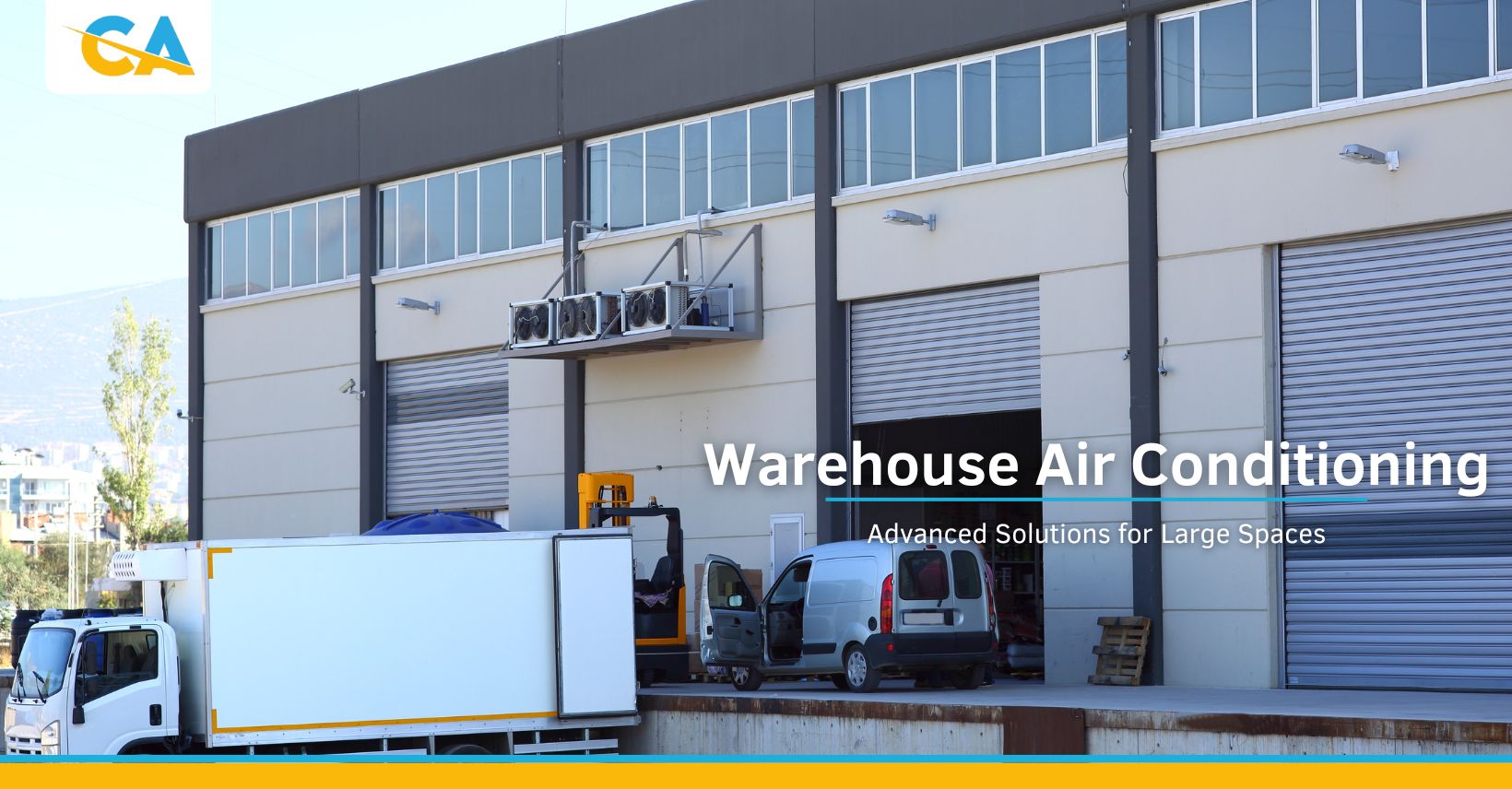Warehouse air conditioning is important for maintaining a comfortable and productive environment for employees working in large warehouses.
We explore the different types of warehouse air conditioning systems, the consequences of poor air conditioning, and the factors to consider when choosing a system.
In addition, we discuss advanced solutions such as High-Volume, Low-Speed (HVLS) fans and thermal energy storage systems, as well as best practices for maintenance and servicing.
Stay tuned for essential tips to ensure superior warehouse air conditioning.
What is Warehouse Air Conditioning?
Warehouse air conditioning controls temperature, humidity, and air quality in storage spaces using HVAC systems to maintain optimal conditions for products and employees.
A common technology is the split system, featuring an indoor unit and an outdoor unit linked by refrigerant lines, which is efficient for cooling large areas and easy to install.
The variable refrigerant flow (VRF) system is another option, enabling different zones within the warehouse to maintain distinct temperatures simultaneously.
These systems enhance comfort, reduce energy consumption, and lower operational costs. HVAC manufacturers in the UK contribute greatly to the economy by offering innovative solutions and creating job opportunities. Ensuring the right air conditioning setup can greatly affect warehouse operations and overall efficiency.
Why is Proper Air Conditioning Important for Warehouses?
Proper air conditioning keeps warehouse temperatures and humidity in check, protecting employee safety and productivity while meeting legal standards.
With it, operations could avoid serious challenges, such as overheating, product damage, and regulatory issues. These potential issues highlight the importance of maintaining an effective system to avoid further complications.
What are the Consequences of Poor Air Conditioning in Warehouses?
Poor air conditioning in warehouses causes excessive heat and humidity, damaging products and harming the environment. High temperatures and moisture lead to spoilage and reduced shelf life, resulting in financial losses.
Employees in these conditions face decreased productivity, fatigue, and health issues, affecting operational efficiency. Inefficient cooling systems also increase energy consumption and carbon emissions, enlarging the environmental footprint.
Implementing effective air conditioning safeguards products improves employee well-being and promotes sustainability and cost-effectiveness. To address these challenges, it’s important to consider various air conditioning solutions customised for warehouse environments.
What are the Different Types of Warehouse Air Conditioning Systems?
Several types of warehouse air conditioning systems are designed to meet the specific needs of different industrial spaces by providing efficient cooling and climate control.
Split System Air Conditioning
Split system air conditioning units, commonly used in warehouses, consist of indoor and outdoor units that work together to provide efficient cooling.
In a split system air conditioning setup, the indoor unit is placed inside the warehouse, typically mounted on a wall or ceiling. It contains an evaporator coil, which cools the air.
On the other hand, the outdoor unit, situated outside, houses the condenser coil and compressor. These components work together to transfer heat from inside to outside, cooling the indoor environment. The two units are connected by refrigerant lines that carry the refrigerant back and forth.
One key advantage of split system air conditioning in warehouses is its versatility. With separate units for indoor and outdoor environments, the warehouse produces less noise pollution, making it an ideal choice for spaces where a quiet working environment is important.
Split system air conditioning units are known for their energy efficiency. Allowing individual temperature control in different warehouse zones helps save energy costs. This feature is particularly beneficial for large warehouses with varying cooling needs in different areas.
Warehouse owners often choose split system air conditioning for efficiency, ease of installation, and low maintenance requirements. The ability to customise cooling solutions for specific areas within the warehouse adds to its appeal, making it a popular choice for ensuring a comfortable working environment during hot summer months.
Packaged Air Conditioning Units
Packaged air conditioning units are self-contained systems ideal for cooling large industrial spaces and warehouses.
One key feature of these units is their compact design, which combines all components, including the compressor, condenser, evaporator, and cooling coil, into a single unit.
This makes installation relatively simple compared to split systems, reducing time and labour costs. Packaged units are efficient in operation, providing consistent and reliable cooling performance.
The maintenance of these units is also convenient, as all components are housed in one location, making it easier for technicians to access and service the unit when needed.
Rooftop Units
Rooftop air conditioning units are installed on the roofs of warehouses, providing effective climate control while maximising floor space.
One major advantage of rooftop units is that they are space-saving, as they do not occupy valuable floor space within the warehouse. This allows businesses to use the entire interior area for storage, production, or other essential functions.
The installation process of rooftop units is relatively straightforward, involving mounting the units on the roof and connecting them to the building’s ductwork. This setup minimises disruption to daily operations and provides a clean aesthetic inside the warehouse.
Variable Refrigerant Flow (VRF) Systems
Variable Refrigerant Flow (VRF) systems are prized for their energy efficiency and flexibility, making them a top choice for HVAC solutions in large warehouses.
VRF systems allow multiple indoor units to connect to one outdoor unit, providing precise control of cooling and heating across different zones within the warehouse.
This technology adjusts refrigerant flow to meet the needs of each zone, optimising temperature control and reducing energy wastage. Advanced sensors and control mechanisms continuously monitor temperature and air quality, ensuring comfortable working conditions and minimising energy consumption. When considering a warehouse air conditioning system, evaluating several factors is essential to make the right choice.
What Factors Should be Considered when Choosing a Warehouse Air Conditioning System?
When selecting a warehouse air conditioning system, factors such as the size and layout of the warehouse, climate and weather conditions, air flow, and the specific cooling needs of industrial spaces must be considered.
Size and Layout of the Warehouse
The size and layout of a warehouse play a vital role in determining the most suitable air conditioning system to ensure optimal cooling and air distribution within the spaces.
For instance, the height of a warehouse is a key factor as it impacts air circulation and the efficiency of the HVAC system. A taller warehouse may require specialised ductwork and fans to ensure proper air movement. The layout of the space, such as the presence of mezzanines or storage racks, can influence airflow patterns and impact temperature distribution.
Climate and Weather Conditions
Climate and weather conditions are important considerations when choosing a warehouse air conditioning system, as they directly affect the temperature and humidity control requirements.
For instance, the air conditioning system must have strong cooling capabilities in regions with extreme heat waves to combat high temperatures effectively.
Similarly, areas with high humidity levels require a system with enhanced dehumidification functions to maintain a comfortable environment. Adapting the system to these external factors ensures optimal performance and energy efficiency, saving costs in the long run. Understanding the local climate patterns helps select the right type of system, whether it be evaporative cooling, split-system, or ducted air conditioning units.
Energy Efficiency
Energy efficiency is key in selecting warehouse air conditioning solutions, as it influences operational costs and environmental sustainability.
Opting for energy-efficient air conditioning systems can reduce electricity bills and lower warehouse owners’ overall maintenance costs. By investing in modern AC units with high energy efficiency ratings, businesses can enjoy a comfortable indoor environment while reducing their carbon footprint.
These systems are designed to operate more efficiently and consume less energy, resulting in considerable cost savings over time. The reduced energy consumption means less strain on the power grid, positively impacting the environment by lowering greenhouse gas emissions.
Maintenance and Repair Costs
Warehouse operators must consider air conditioning systems’ maintenance and repair costs to ensure reliability and cost-effectiveness. System complexity, component quality, maintenance frequency, and technician expertise can greatly impact these costs.
The system’s age and usage patterns also determine upkeep requirements. Therefore, it is essential to opt for air conditioning systems with predictable and manageable upkeep needs.
Predictable maintenance requirements allow operators to plan and budget, avoiding sudden repair cost spikes. Systems with manageable upkeep are easier to maintain, resulting in lower maintenance costs over their lifespan.
Understanding these aspects paves the way for exploring more sophisticated options that can address the unique challenges of large warehouse environments.
What are the Advanced Solutions for Large Warehouse Air Conditioning?
Advanced solutions for large warehouse air conditioning include:
- High volume, low speed (HVLS) fans
- Evaporative cooling systems
- Thermal energy storage systems
Each is designed to provide efficient cooling for expansive industrial spaces.
High Volume, Low Speed (HVLS) Fans
High-volume, Low-Speed (HVLS) fans, such as axial fans, are effective in circulating large volumes of air at low speeds, making them ideal for maintaining airflow in large warehouses.
These fans work by moving air from above and pushing it downwards in a controlled manner, creating a gentle breeze throughout the warehouse.
The slow-moving air covers a large area, providing consistent airflow and helping to regulate temperature and humidity levels. This circulation helps reduce condensation, prevent stagnant air pockets, and promote a healthier environment for workers.
Evaporative Cooling Systems
Evaporative cooling systems, which use evaporative coolers, offer an energy-efficient method of cooling large spaces by leveraging the natural process of water evaporation.
These systems draw warm, outside air through water-saturated pads, where the water evaporates, extracting heat from the air and lowering its temperature. The now-cooled air is circulated through the space, creating a comfortable environment.
One of the key advantages of evaporative cooling is its cost-effectiveness, as it typically consumes much less electricity compared to traditional air conditioning systems. Evaporative coolers provide fresh, humidified air, which can be beneficial in dry environments.
Thermal Energy Storage Systems
Thermal energy storage systems store excess cooling energy during off-peak hours and release it during peak hours, providing steady climate control in large warehouses.
This technology helps warehouse owners reduce energy consumption and operational costs. Using stored thermal energy, these systems lower the peak demand on the electrical grid, leading to cheaper energy bills.
They also support sustainable and eco-friendly warehouse operations by reducing reliance on traditional, electricity-intensive cooling methods. Maintaining a consistent climate can greatly impact employee productivity and comfort, highlighting how warehouse air conditioning is important to workforce efficiency.
How Can Warehouse Air Conditioning Help with Employee Productivity and Comfort?
Warehouse air conditioning boosts productivity and comfort by keeping temperature and humidity levels just right, which is vital for a safe and conducive work environment.
Employees in a well-conditioned warehouse face fewer distractions from discomfort, allowing them to focus on their tasks with better concentration and efficiency.
Consistent temperature control prevents equipment malfunctions and product spoilage, reducing downtimes and operational costs. Ventilation systems ensure employees breathe clean, filtered air, promoting health and well-being.
A comfortable, controlled warehouse environment leads to happier, healthier, and more productive workers. This seamless operation hinges on regular upkeep and efficient servicing techniques to keep the systems in top condition.
What are the Best Practices for Maintaining and Servicing Warehouse Air Conditioning Systems?
Regular maintenance and service of warehouse air-conditioning units are key to keeping them efficient, extending their lifespan, and avoiding unexpected breakdowns.
Scheduling routine inspections helps identify leaks, blockages, or worn components that could cause issues. Cleaning air filters, coils, and ductwork is vital for smooth operation, as dust and debris can impede airflow and lower efficiency.
Proactively replacing worn parts, like belts, fans, and motors, according to manufacturer guidelines can prevent costly repairs and downtime. To further enhance your understanding and keep your systems in top shape, stay tuned for some final, essential tips that can make all the difference.
Essential Tips for Superior Warehouse Air Conditioning
Achieving superior warehouse cooling involves selecting the right air conditioners and solutions customised to an industrial space’s specific needs, ensuring energy efficiency, and adhering to regular maintenance practices.
When choosing air conditioning systems for warehouses, the size and layout of the space must be considered to determine the most suitable unit capacity. Opting for energy-efficient models can greatly reduce operational costs while minimising environmental impact.
Regular maintenance checks, such as filter replacements and system inspections, are essential to ensure optimal performance and prolong the lifespan of the equipment.
Creating a maintenance schedule and partnering with a professional HVAC service provider can streamline this process and prevent unexpected breakdowns.





